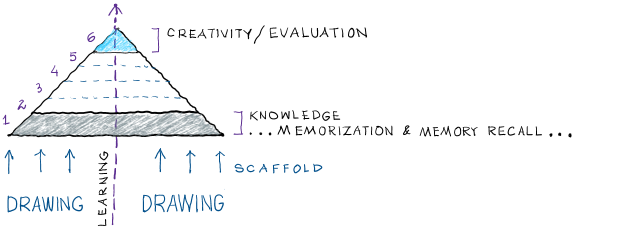
Drawing as a self-scaffold
October 22, 2021Scaffolding techniques in learning and teaching
PRACTICE NOTE by Narendra Kaley
For learning to be effective, memorisation and memory-recall constitute one of the most fundamental elements of learning taxonomy. The overall process of learning hinges upon the learner’s capacity to enhance memory such that a positive change can be instilled in the long-term memory. Such an affect procures knowledge. Bloom’s Taxonomy (Bloom, Englehart, Furst, Hill, & Krathwohl, 2021) places “gain of knowledge” as the first step in learning; and, for it to be a life-long pursuit, it is important to have a wide and a stable base of knowledge.
To gain knowledge, along with many other factors, focusing attention on a learning task is a pre-requisite. Roy Killen in his book “Effective Teaching Strategies” quotes Judy Willis “…each time a student focuses attention, the activation of alerting and focusing pathways in the brain results in these attention circuits becoming stronger and more efficient at carrying new data into long-term memory” (Killen, 2016). Establishing long-term memory is a step towards effective learning and expertise.

Memory is a collective of constructive processing of three aspects of information—encoding, storage and retrieval. All these operate in synchronicity, but how well a schema is formed depends primarily on the quality of encoding which is a direct result of sensory input (McLeod, 2013). Encoding can occur in four different ways that are Acoustic, Visual, Tactile and Semantic (Savage, 2018). Drawing is one of those rare techniques that not only combines Visual, Tactile and Semantic sensory inputs but also imparts the virtues of patience and focusing attention to the practitioner. A student with drawing as a tool for learning has a very effective self-scaffold in the journey.
Psychologicalscience.org mentions a recent research by Myra Fernandes, Jefferey Wammes and Melissa Meade of University of Waterloo, concluding that “…drawing to encode information surpasses other strategies, such as writing, mentally visualizing, or viewing photos of the information…the benefit does not depend on participants’ artistic abilities and occurred even when they had only 4 seconds to draw” (Association for Psychological Science, 2018). Most importantly, they have found that drawing improves/increases memory across a variety of tasks because of seamless integration of pictorial (Visual), motoric (Tactile) and elaborative (Semantic) components of information encoding.
Enhanced memory is a desired outcome in learning, laying robust foundation for gain of knowledge and the path of learning towards creation. Furthermore, it becomes a very tempting proposition due to the easy, convenient, joyful, relaxing, and inexpensive attributes of Drawing.
References
Association for Psychological Science. (2018, October 22). For Learning, Drawing a Picture May Really Be Worth a Thousand Words. Retrieved October 15, 2021, from www.psychologicalscience.org.
Bloom, B., Englehart, M., Furst, E., Hill, W., & Krathwohl, D. (2021, October). Retrieved from www.bloomstaxonomy.net.
Killen, R. (2016). Effective Teaching Strategies : Lessons from Research and Practice. Newcastle: Cengage Learning.
McLeod, S. (2013). Stages of Memory. Retrieved October 15, 2021, from www.simplypsychology.org.
Savage, M. (2018, June 25). The Role of Memory in Learning – Encoding. Retrieved October 15, 2021, from www.elearningindustry.com.


